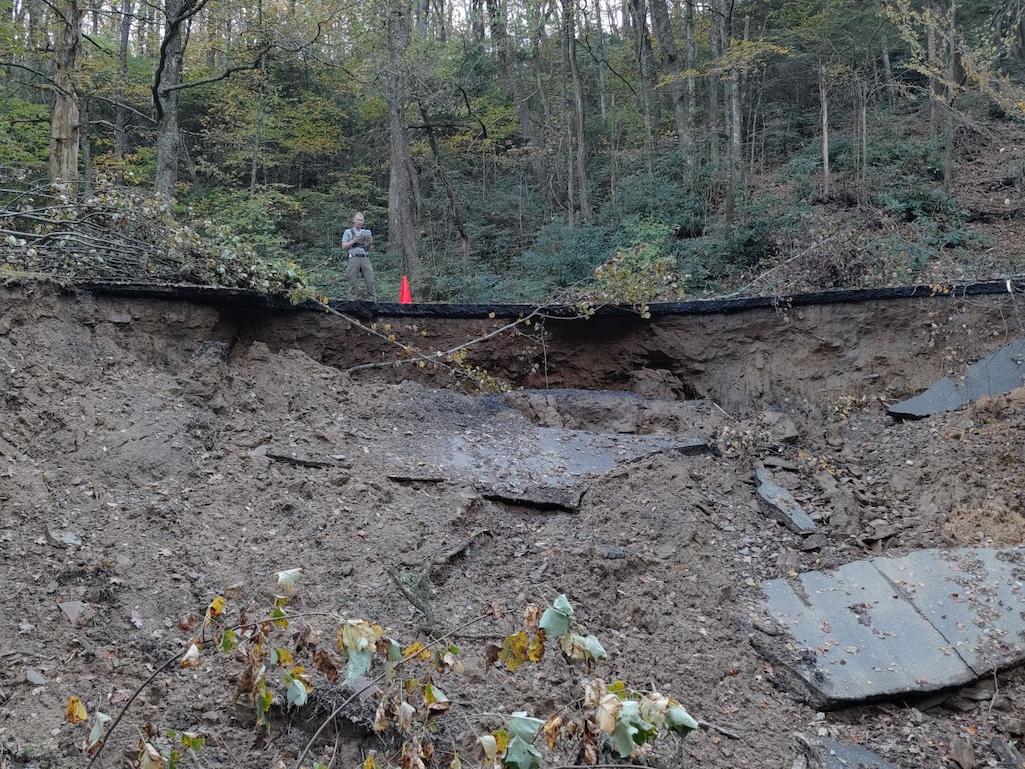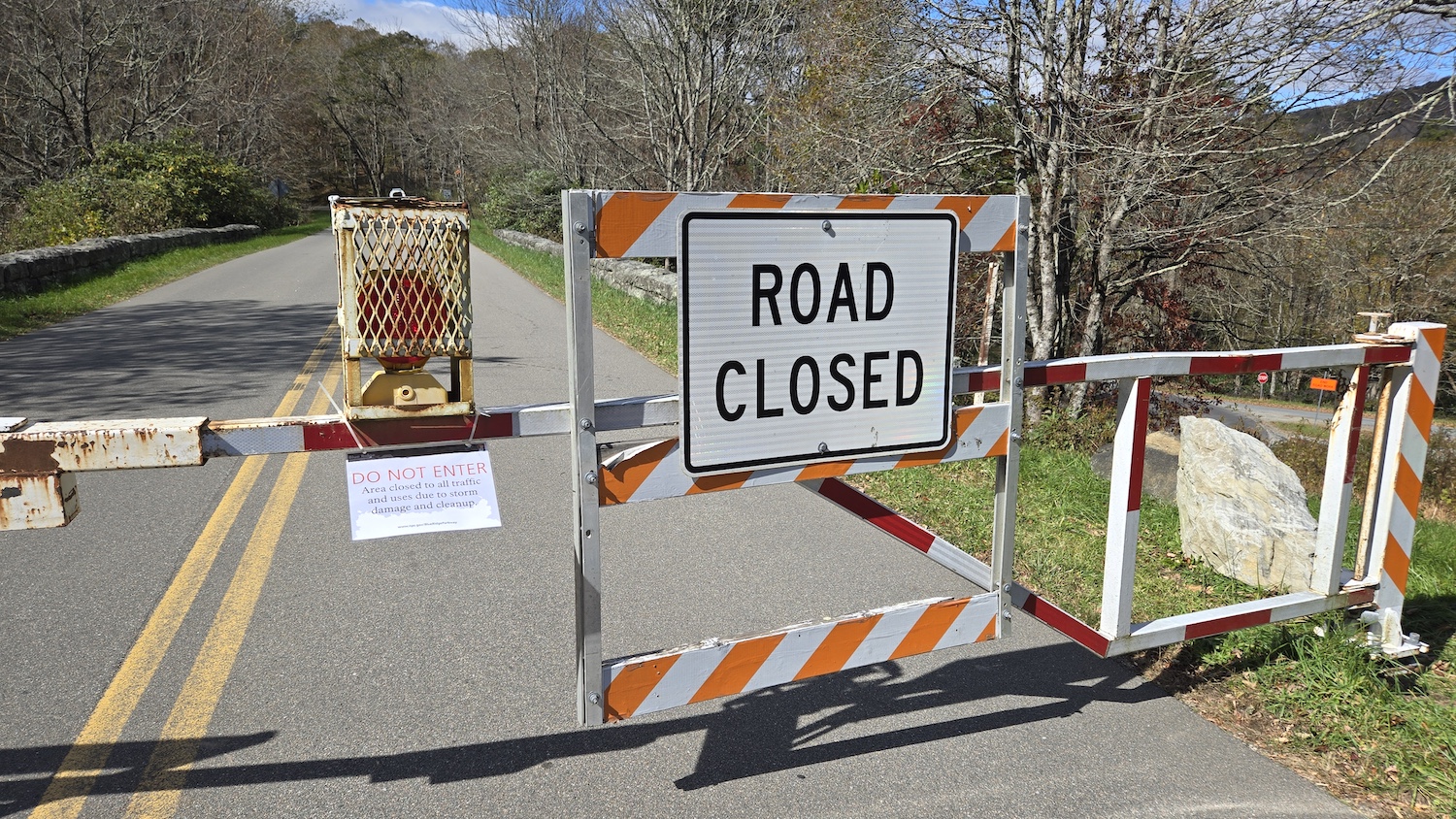BLUE RIDGE PARKWAY, North Carolina — On a mid-October morning on the Blue Ridge Parkway near the gateway town of Blowing Rock, North Carolina, the autumn leaves were nearing their peak color. All around me, gold, red, and orange leaves shimmered in the treetops and fluttered gently to the earth. I had driven from my hometown near Washington, D.C., to the area to learn about the economic impacts of Hurricane Helene on the park’s nearby communities, and I had decided to drive up to the parkway to see what I could see.
I didn’t get very far. Normally, the crescendo of fall fireworks would have drawn a steady stream of leaf-peepers, but instead, the parkway was eerily empty. In one direction, the scenic byway was open only to trucks and heavy equipment carrying National Park Service workers and contractors who were tasked with clearing downed trees and debris. In the other direction, a gate blocked the roadway with a sign reading, “Road Closed.”
A Category 4 hurricane at its peak, Helene cut a swath of destruction from the Gulf of Mexico north through Georgia, eastern Tennessee, and western North Carolina. With more than 230 lives lost across the South, Helene was the deadliest hurricane to hit the mainland United States since Katrina in 2005. The full cost of the damage and recovery in North Carolina alone is estimated to be more than $53 billion, according to a state assessment.
On top of that, the blow to the state’s tourism economy is also immense. Tourism spending had been on an steady rising trend in North Carolina; in 2023, the state recorded $35.6 billion in visitor spending and, through this July, visitation to the parkway was up roughly 105,000, according to the latest Park Service figures available.
As the Traveler reported, hurricane damage and massive flooding forced the temporary closure of portions of Great Smoky Mountains National Park, as well as the entire 469 miles of the Blue Ridge Parkway, which links Great Smoky in the south with Shenandoah National Park in the north. While the entire stretch of the parkway in Virginia has reopened, only about 88 miles of the road in North Carolina has reopened as of this writing. In some sections, the parkway needs to be completely rebuilt.

Several spots along the parkway suffered road damage that won't be quickly repaired/NPS file
“October represents 25 percent of my yearly revenue,” says Bruce O’Connell [no relation to the author], the longtime concessioner of the Pisgah Inn that sits on the parkway at milepost 408 in North Carolina and is open only from April 1 to October 31. “Losing October was a big hit. It also means that not only do I have one extra month of not generating revenues, but I still have to pay the ongoing fixed expenses.”
Although it’s still difficult to determine the total income Helene cost the gateway towns, when we consider that Great Smoky Mountains visitors spent about $2.1 billion in local towns in 2022 and supported more than 32,000 jobs, and that western North Carolina contributes an estimated $7.7 billion in visitor dollars to the state, the impacts are likely to be long-lasting and severe.

Asheville artist Heather Divoky's work titled "Appalachia"/Heather Divoky
Struggling Small Businesses
In the early days after the storm, government officials recommended that tourists avoid the most flooded and damaged areas, and countless visitors cancelled their plans. But for many of the gateway towns to these national parks—places like Boone, Blowing Rock, Asheville, Cherokee, and Canton in North Carolina—the loss of tourism dollars in one of the most popular months has added another serious challenge to communities already grappling with the loss of life and property.
In Asheville, one of the hardest-hit towns near Great Smoky Mountains, Helene-fueled floodwaters reached neighborhoods so quickly that many houses washed away with little warning. Sitting in her art studio, pen-and-ink artist Heather Divoky recalled the devastation in the River Arts District, a consortium of artists who work and sell their wares along the French Broad River in downtown Asheville.
“We’re one of the very fortunate ones,” Divoky says. “The river came within inches of our building. We did get some water inside, but my building did not get wiped off the planet. But probably about 80 percent of the buildings [in the district] were compromised, meaning having some kind of damage. And it’s probably about 60 percent that were completely flooded, meaning water to the second floor.”
The River Arts District is a favorite among fall visitors who enjoy strolling through the studios. Much of the art produced in the district is related to the very nature that draws people to the area, Divoky says.
“The leafers are a huge piece of our economic makeup,” Divoky says. “We all live up here, and we get so much inspiration from our surroundings. Most of us at any given time have had a series or a piece inspired by the mountains. To be honest, I was not able to work for the first few weeks. I just picked up the pen and started crying. So I found myself putting my energy into different avenues like volunteering.”
Not far away, the town of Canton—about midway between Asheville and Maggie Valley—also suffered great losses that weren’t covered as often in the national press. Although not as much of a destination town as others, Canton still gets its fair share of hikers and other park visitors.
“Driving from Asheville to Canton after the storm had cleared out, we saw the French Broad River at its highest,” says the Reverend Esta Jarrett, pastor of the Canton Presbyterian Church. “It was almost even with Interstate 26. We saw buildings, businesses, completely underwater. We saw the debris, the trees down, the power lines down everywhere. So that was really gut-wrenching to see all of that firsthand and continues to be. It feels like a personal grief, like a death in the family.”
Jarrett connected me with her friend and fellow Canton resident, Aimee Sylvester, who talked with me about the storm's impacts on the Mill Town Farmers Market, for which she serves as vice president of the market's board of directors. Sylvester had helped found the market in Canton as a means of boosting local businesses after the town suffered a devastating flood in 2021 and later saw the closure of its paper mill, a major employer. So when Helene then washed out the market site and flooded its storehouse, it felt a bit like beating someone when they were already down.
“I'm going to get emotional,” Sylvester began, her voice breaking. “There's been a lot of obstacles in our small town because of the overall economic situation here. The farmers market has already faced several challenges. And maybe [some could say] it’s not an immediate and sudden and urgent need that the market make it, but it is. It feels like it in some ways. It is because it's one of those existential things that allows us to stay connected and boost morale at a time like this.”
Riding The Storm Out
Back in Blowing Rock, I spent some time talking with three people who were intimately aware of how this gateway town was faring economically after Helene: Mayor Charlie Sellers, who also owns the Blowing Rock Attraction, the mountain outcropping for which the town is named; Tracy Brown, executive director of the town’s tourism development authority; and Charles Hardin, director of the Blowing Rock Chamber of Commerce.
With the parkway closed, however, the town’s rooms, restaurants, and sidewalks were noticeably emptier than usual. The messaging around promoting tourism was tricky, too, because town officials didn’t want to appear too eager to reopen and be insensitive to their neighboring towns that were still in triage mode. Nor did they want to encourage “disaster tourism,” the kind of rubbernecking that could potentially get in the way. So the town was very measured in how they promoted travel, the officials told me.
“The parkway is, I believe, the No. 1 economic generator for this whole county,” Hardin says. “We are the only full-service community directly on the parkway, so we do get a lot of overnight stays and people stopping here to shop and dine and so forth, so the timing is the really big issue.”
“If this had happened in another month, the damage to businesses would've been a lot different,” Brown says. “Typically, most businesses here will tell you that October is what gets them through the winter, which is when things really slow down. So I'm sure we'll probably see, if not in this community, then all around us, businesses that are forced to permanently close.”
The Blowing Rock Attraction, for its part, which offers stunning views of the Blue Ridge Mountains in all directions, has always benefited from its proximity to the parkway. So when the parkway closes, the impacts on the attraction are immediately felt, Mayor Sellers says.
“We're down about 65 to 70 percent vs. last year,” he explains. “A lot of our clientele come off the parkway, and also from Charlotte and eastern Tennessee and eastern North Carolina and many other places. But I would say the parkway alone probably contributes 25 percent of our business.”

T-shirts pointed to the resiliency of North Carolinians/Kim O'Connell
The Long View
On my last day in western North Carolina, I stopped by the town of Boone for eggs benedict at Melanie’s, a longtime local eatery, and some shopping in its picturesque downtown. I happened to be there the day that Appalachian State University was welcoming students back on campus after the storm, and the buzz of positivity was palpable.
Still, there were signs of what had happened: A marquee on a community center read, “Standing with Our Boone Community,” and charity t-shirts were for sale with phrases like “North Carolina Strong” and “Mountain Strong.” Not far away, a distribution center was humming with volunteers serving meals and gathering donations for those still displaced.
Up and down western North Carolina, people are returning to the parks and to their gateway towns. At press time, art workshops were being advertised in the River Arts District in Asheville, and the Mill Town Farmers Market was up and running in a temporary site and planning to open a Christmas market as well.
At the Pisgah Inn, O’Connell was hoping for a grant or some aid to replace all the doors at the inn, a long-delayed maintenance project that he hopes will happen either before or soon after the inn reopens, ideally on time on April 1st.
And in Boone, Chamber of Commerce President & CEO David Jackson is working to help local businesses weather the economic storm, whether that’s outreach about government aid programs or other assistance. “It’s complicated because usually we are ‘Come one, come all,’” he says. “And now it's ‘Come with caveats’—tread lightly and be respectful of the fact that the person that may be serving you lunch also lost their home.”
For the most part, it seems that visitors are hearing that message. “We have a very loyal fan base—folks that visit here, in some cases for generations,” Tracy Brown says. “They recognize what’s happened and are willing to step up to help. And they do that because they love this place. They love this region.”
Donations for ongoing hurricane relief can be made through the Blue Ridge Parkway Foundation.






 Support Essential Coverage of Essential Places
Support Essential Coverage of Essential Places






